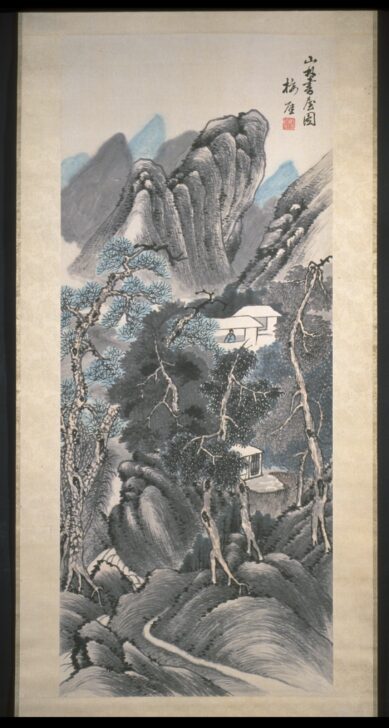Studio in the Mountain Forest
Totoki Baigai

Description
Subject Matter:
"Baigai is occasionally listed as a disciple of Ike Taiga (1723-1776), and several works in his style including the wonderful copy of the Juben Jugi album done in 1800 and now in the Burke collection still exist. Even though it is possible that Baigai met Taiga. it seems unlikely that he became his disciple, for the great majority of Baigai's paintings show no such influence. Although he occasionally painted figures. Baigai is primarily known for his landscapes that range from carefully constructed compositions to bizarre mountains freely brushed.
This carefully composed painting, Studio in the Mountain Forest, is one of Baigai's strangest and most powerful landscapes."
"The seal and the style of the signature are somewhat unusual for Baigai. but they are occasionally found on other paintings. A similar signature is on a Baigai painting in the Hashimoto collection in Takatsuki. A different version of the same seal is on one of the Baigai paintings in the Powers collection and on another Baigai painting introduced in Kokka, no. 953. Among the varied works by an expressive individualist. this landscape emerges as one of his most exciting creations."
Adams, Celeste, and Paul Berry. Heart, Mountains, and Human Ways: Japanese Landscape and Figure Painting: a Loan Exhibition from the University of Michigan Museum of Art. Museum of Fine Arts, 1983.
Physical Description:
"As the path leads the eye into the picture from the right, the ground seems to swell until it bulges wildly over a stream whose surface can be briefly glimpsed. The middle of the painting is dominated by very tall twisting treetrunks laden with large masses of foliage through which can be seen several houses. At the top loom various mountains slanting off to the right. In the manner of Buson (1716-1783) or one of his followers, a figure seated in the window of a house calmly stares out at the viewer. This painting takes the love of unusual natural shapes found in Chinese literati painting further into a world of complete fantasy wherein every form seems alive and strangely animated. The brushwork is a mixture of dry and wet strokes and washes. The dark moss dots that outline the contours of the rocks add to the overall dramatic effect. At the top of the three largest trees are dark branches that are depicted with single strokes, rather than outlined as the trunks below. These were finishing touches by the artist who felt that something more was needed to complete the composition." There is a seal and a signature.
Adams, Celeste, and Paul Berry. Heart, Mountains, and Human Ways: Japanese Landscape and Figure Painting: a Loan Exhibition from the University of Michigan Museum of Art. Museum of Fine Arts, 1983.
Usage Rights:
If you are interested in using an image for a publication, please visit https://umma.umich.edu/request-image/ for more information and to fill out the online Image Rights and Reproductions Request Form.